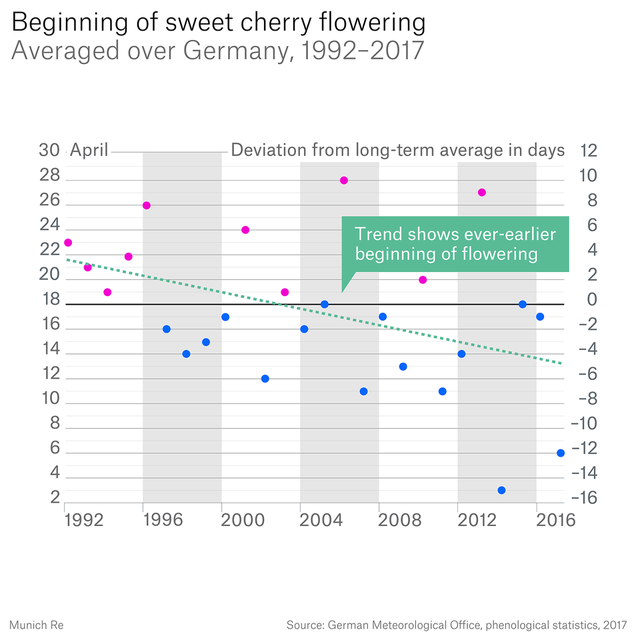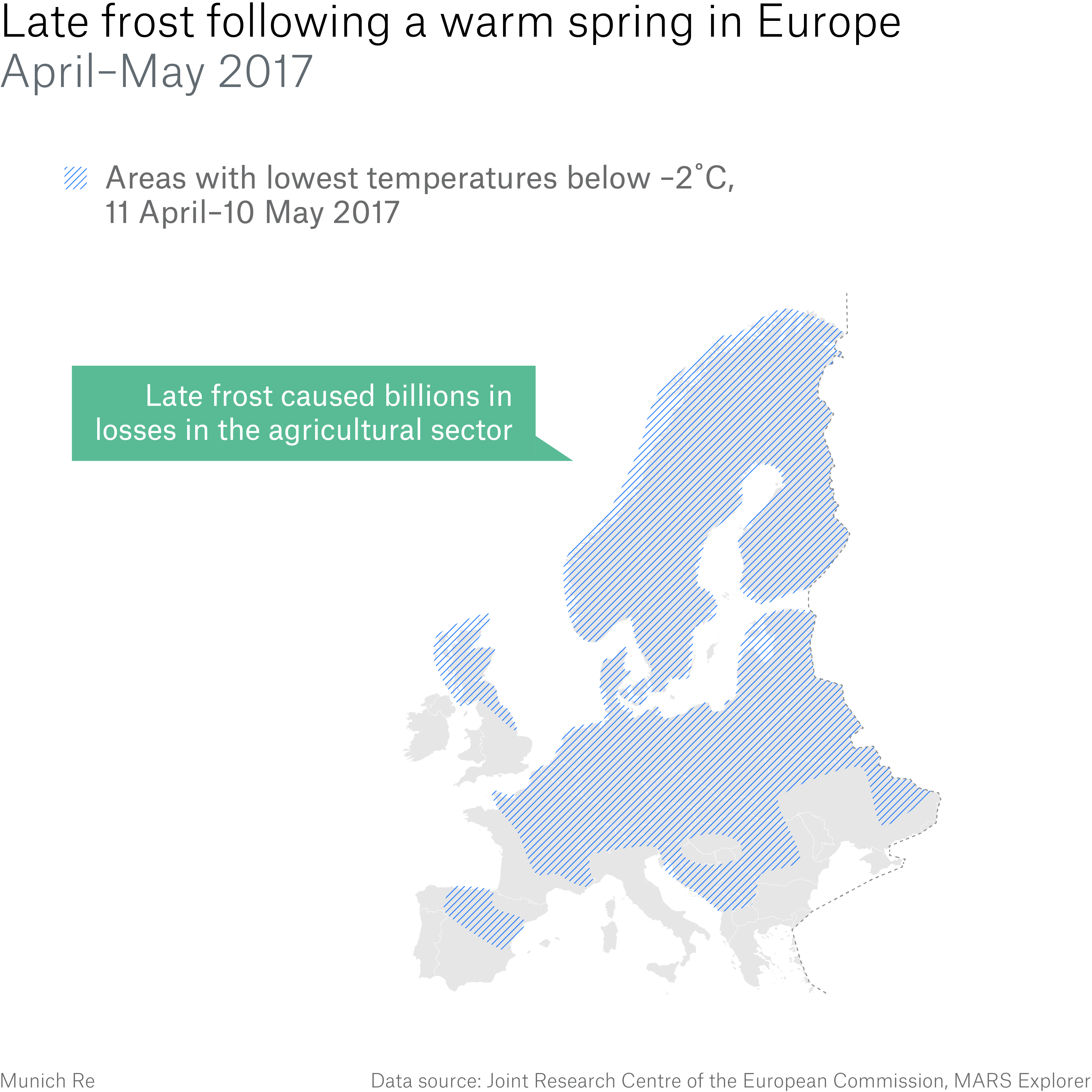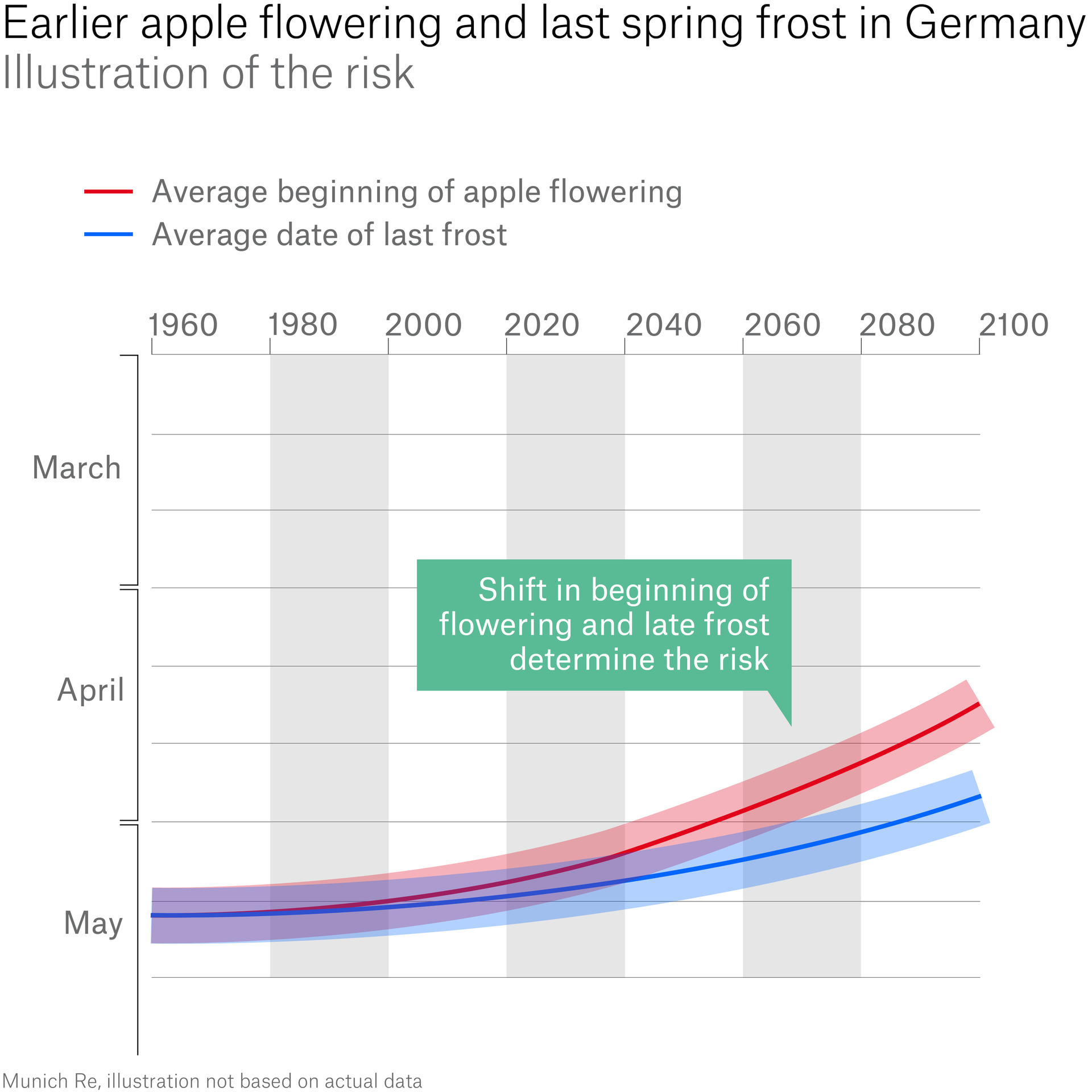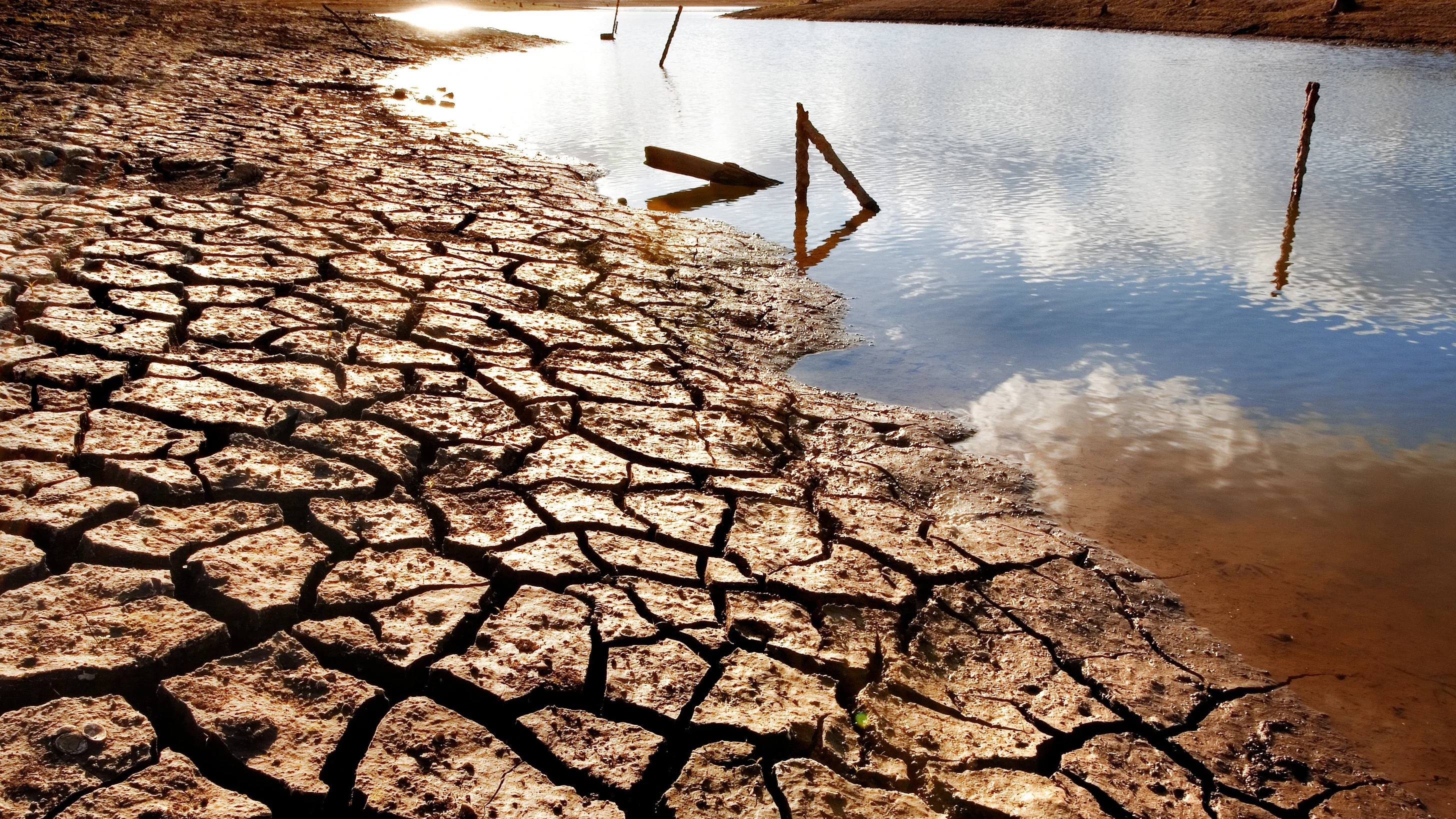
properties.trackTitle
properties.trackSubtitle
In the second and third ten-day periods of April, and in some cases even over the first ten days of May 2017, western, central, southern and eastern Europe experienced a series of frosty nights, with catastrophic consequences in many places for fruit growing and viticulture. The worst-affected countries were Italy, France, Germany, Poland, Spain and Switzerland. Losses were so high because vegetation was already well advanced following an exceptionally warm spell of weather in March that continued into the early part of April.
For example, the average date of apple flowering in 2017 for Germany as a whole was 20 April, seven days earlier than the average for the period 1992 to 2016. In many parts of Germany, including the Lake Constance fruit-growing region, it even began before 15 April. In the case of cherry trees – whose average flowering date in Germany in 2017 was 6 April – it was as much as twelve days earlier than the long-term average. The frost had a devastating impact because of the early start of the growing season in many parts of Europe. In the second half of April, it affected the sensitive blossoms, the initial fruiting stages and the first frost-susceptible shoots on vines.

Meteorological conditions
The weather conditions that accounted for the frosty nights are a typical feature of April, and also the reason for the month’s proverbial reputation for changeable weather. The corridor of fast-moving upper air flow, also known as the polar front, forms in such a way that it moves in over central Europe from northwesterly directions near Iceland. This north or northwest pattern frequently occurs if there is high air pressure over the eastern part of the North Atlantic, and lower air pressure over the Baltic and the northwest of Russia. Repeated low-pressure areas move along this corridor towards Europe, bringing moist and cold air masses behind their cold fronts from the areas of Greenland and Iceland. Occasionally, the high-pressure area can extend far over the continent in an easterly direction. The flow then brings dry, cold air to central Europe from high continental latitudes moving in a clockwise direction around the high.
It was precisely this set of weather conditions with its higher probability of overnight frost that dominated from mid-April to the end of the month. There were frosts with temperatures falling below –5°C, in particular from 17 to 24 April (second and third ten-day periods of April), and even into the first ten-day period of May in eastern Europe. The map in Fig. 2 shows the areas that experienced night-time temperatures of –2°C and below in April/May.

High losses in fruit and wine growing
Frost damage to plants comes from intracellular ice formation. The cell walls collapse and the plant mass then dries out. The loss pattern is therefore similar to what is seen after a drought. Agricultural crops are at varying risk from frost in the different phases of growth. They are especially sensitive during flowering and shortly after budding, as was the case with fruit and vines in April 2017 due to the early onset of the growing season. That was why the losses were so exceptionally high in this instance. In Spain, the cold snap also affected cereals, which were already flowering by this date.
Even risk experts were surprised at the geographic extent and scale of the losses (overall losses: €3.3bn, insured losses: approximately €600m). Overall losses were highest in Italy and France, with figures of approximately a billion euros recorded in each country.
Two basic concepts for frost insurance
As frost has always been considered a destructive natural peril for fruit and wine growing and horticulture, preventive measures are widespread. In horticulture, for example, plants are cultivated in greenhouses or under covers, while in fruit growing, frost-protection measures include the use of sprinkler irrigation as well as wind machines or helicopters to mix the air layers. Just how effective these methods prove to be will depend on meteorological conditions, which is precisely why risk transfer is so important in this sector. There are significant differences between one country and the next in terms of insurability and insurance solutions. But essentially there are two basic concepts available for frost insurance:
- indemnity insurance, where hail cover is extended to include frost or other perils
- yield guarantee insurance covering all natural perils
In most countries, the government subsidises insurance premiums, which means that insurance penetration is higher. In Germany, where premiums are not subsidised and frost insurance density is low, individual federal states like Bavaria and Baden-Württemberg have committed to providing aid to farms that have suffered losses – including aid for insurable crops such as wine grapes and strawberries.
Late frosts and climate change

Because of the different climate zones in Europe, the race between these processes is likely to vary considerably. Whereas the east is more heavily influenced by the continental climate, regions close to the Atlantic coastline in the west enjoy a much milder spring. A study has shown that climate change is likely to significantly reduce the spring frost risk in viticulture in Luxembourg along the River Moselle1. The number of years with spring frost between 2021 and 2050 is expected to be 40% lower than in the period 1961 to 1990.
By contrast, a study on fruit-growing regions in Germany2 concluded that all areas will see an increase in the number of days with spring frost, especially the Lake Constance region, where reduced yields are projected until the end of this century. At the same time, however, only a few preliminary studies have been carried out on this subject, so uncertainty prevails.
Outlook
The spring frost in 2017 illustrated the scale that such an event can assume, and just how high losses in fruit growing and viticulture can be. Because the period of vegetation is starting earlier and earlier in the year as a result of climate change, spring frost losses could increase in the future, assuming the last spring frost is not similarly early. It is reasonable to assume that these developments will be highly localised, depending on whether the climate is continental or maritime, and whether a location is at altitude or in a valley.
Regional studies with projections based on climate models are still in short supply and at an early stage of research. However, one first important finding is that the projected decrease in days with spring frost does not in any way imply a reduction in the agricultural spring frost risk for a region. So spring frosts could well result in greater fluctuations in agricultural yields. In addition to preventive measures, such as the use of fleece covers at night, sprinkler irrigation and the deployment of wind machines, it will therefore be essential to supplement risk management in fruit growing and viticulture with crop insurance that covers all natural perils.
1 Molitor et al., 2014, Journal of Grape and Wine Research, 20, 160-168
2 Chmielewski et al, 2010, in Matzarakis et al., 2010: Proceedings of the 7th Conference on Biometeorology, 50-56



